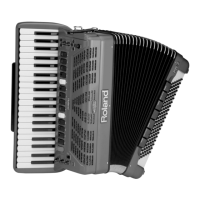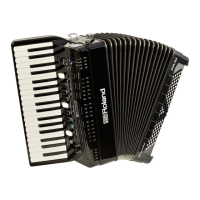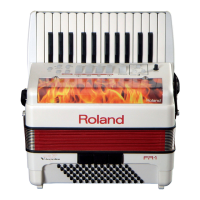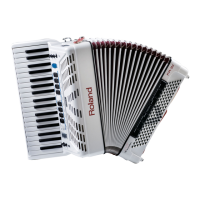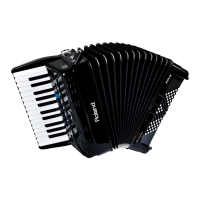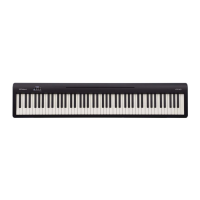Menu Options
78
Parameter Value Explanation
FOOT All, 16’, 8’
Chose the reed you wish to assign
another sound to.
NOTE
Whenever you select “All” and set a
dierent reed type, the “VALVE NOISE”
setting (p. 72) is automatically
adapted to the reed type you select
here. You may have to change it
afterwards if you wish to use a
dierent noise type.
STATUS
O, Low, High,
Whole
To specify whether the selected reed
should sound and which bass buttons
can be used to play it.
• “O”: No sound
• “Low”: the lower half
• “High”: the upper half
• “Whole”: all buttons
These options allow you to program
what keyboard players would call a
“split”. You can create several nifty
combinations, like “High” for 8’ and “Low”
for 16’ (or vice versa), or “Whole” for 16’
(all buttons) and “High” for 8’ (only the
upper three rows).
NOTE
Assigning the same partial “STATUS”
(“High” or “Low”) to both reeds means
that only half the number of available
bass buttons can be used.
LEVEL O, –40~Std~40
It allows you to create the desired “mix”
(volume balance) for the active reeds.
This is a relative parameter: its value
is added to or subtracted from the
standard value (“Std”). As a rule, rst
decide which reed is most important
and set its “Volume” parameter to “Std”.
Then reduce or increase the volume of
the “ancillary” reeds to create the desired
balance.
FREE BASS
NOISE
Bandoneon , I-Folk,
I-Folk2, Classic,
Cajun, Jazz, F-Folk,
D-Folk, Organetto,
F-Folk2, Classic2,
Studio, Tradition,
Steierische,
Trikitixa, F-Jazz,
Classic3, Bajan
The bass section of almost all accordion
instruments can be played via buttons.
Such buttons produce a typical noise
when pressed.
You can select the instrument whose
button noises should be used when you
select this register. (Note that other Free
Bass registers can be assigned dierent
noises.)
LEVEL O, –40~Std~40
Use the “LEVEL” parameter to specify how
prominent the noise should be.
NOTE
Whenever you select “ALL” for “4.1 Reed
Type” and set a dierent reed type, this
noise setting is automatically adapted
to the reed type you select. It would
therefore be a good idea to rst select
the reed type and only then change the
noise type
4.3 Eect Send
On this page, you can adjust the Reverb, Chorus
and Delay eect for the bass section.
Parameter Value Explanation
REVERB 0~127
Use these parameters to set the
Reverb, Chorus or Delay send levels
(how much eect should be applied
to the Free Bass section).
The higher the value you set, the more
the Free Bass section (which includes
the chord buttons) will be processed
by the eect in question.
CHORUS 0~127
DELAY 0~127
4.4 Controllers
In this page you can control the bellows detune.
Parameter Value Explanation
BELLOWS DETUNE
O, Low, Standard,
High
Here, you can specify how
strongly the pitch of the
simulated Free Bass reed(s)
changes when you open or
close the bellows faster than
usual.
If the “Standard” setting seems
too mild, try “High”. If it is too
strong, use “Low”. If you do
not want any detuning eect,
select “O”.
The most convincing
setting usually depends on the
selected instrument(s). See “4.1
Reed Type” (p. 77).
4.5 FREE BASS MIDI TX
This parameter further adds to the realism of the
sounds emulated by your FR-8x.
Parameter Value Explanation
Note Tx
On, O
Default: On
See “2.7 MIDI TX” (p. 73) for
details.
Octave
–3~0~+3
Default: 0
See “2.7 MIDI TX” (p. 73) for
details.
CC 00
Std, O, 0~127
Default: Std
See “2.7 MIDI TX” (p. 73) for
details.
CC 32
PC
Std, O, 1~128
Default: Std
See “2.7 MIDI TX” (p. 73) for
details.
Volume
O, 0~127
Default: 100
See “2.7 MIDI TX” (p. 73) for
details.
Panpot
O, 0~127
Default: 64
See “2.7 MIDI TX” (p. 73) for
details.
Reverb
O, 0~127
Default: 40
See “2.7 MIDI TX” (p. 73) for
details.
Chorus
O, 0~127
Default: 0
See “2.7 MIDI TX” (p. 73) for
details.
Velocity
On, 1~127
Default: On
See “2.7 MIDI TX” (p. 73) for
details.
Expression
O, Bellows, Pedal
Default: Belows
See “2.7 MIDI TX” (p. 73) for
details.

